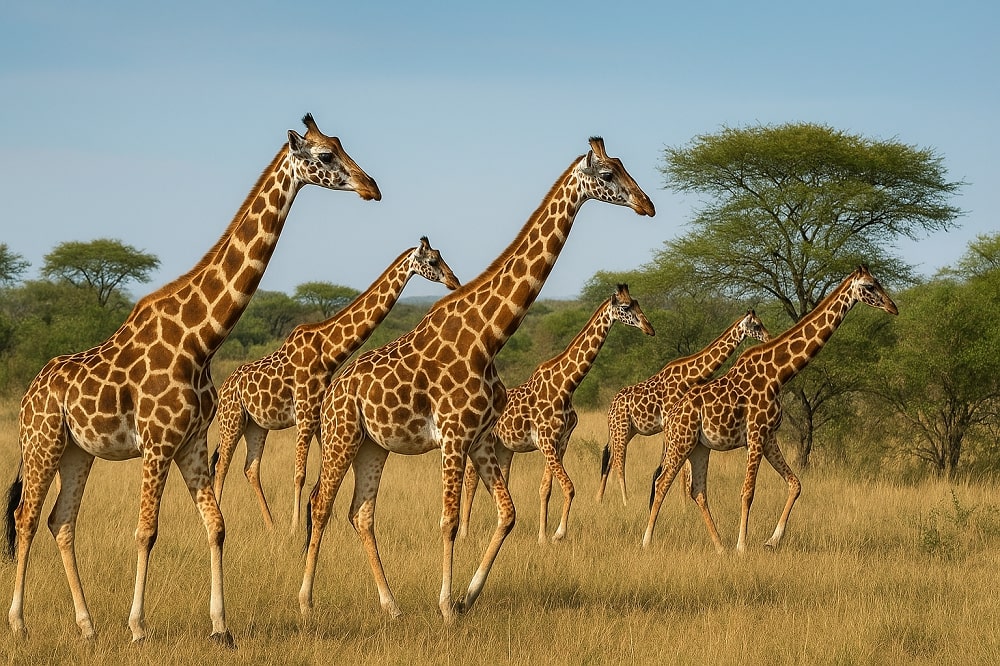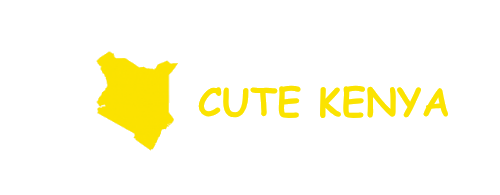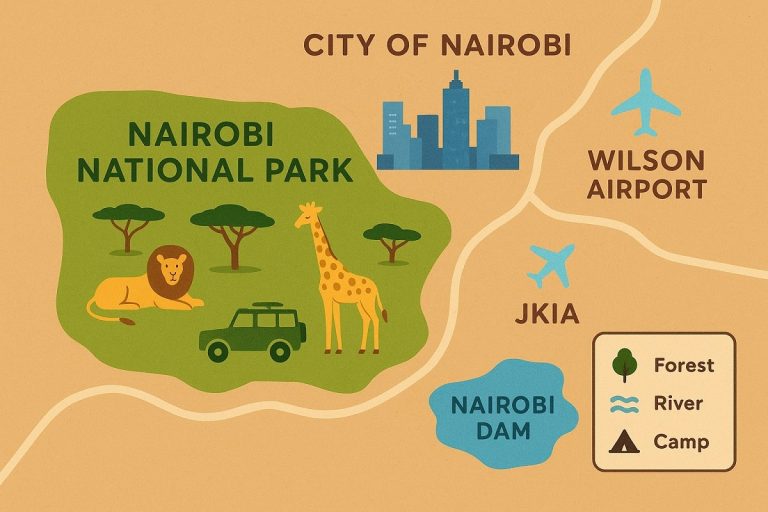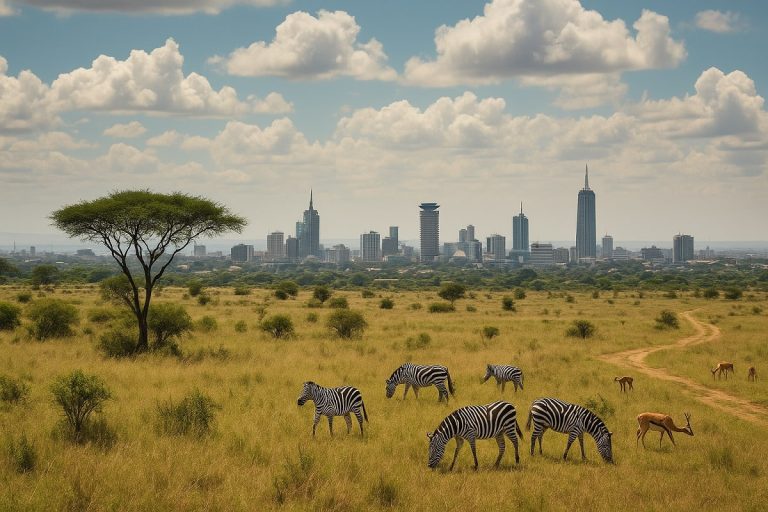The Giraffe centre in Nairobi Kenya

Tucked away in the leafy suburb of Langata, just 20 kilometers from Nairobi’s city center, lies one of Kenya’s most iconic wildlife sanctuaries — the Giraffe Centre. Famous for its up-close encounters with the towering Rothschild’s giraffe, this conservation hub blends education, tourism, and environmental stewardship into one unforgettable experience.
More than just a tourist attraction, the Giraffe Centre is the beating heart of the African Fund for Endangered Wildlife (AFEW-Kenya), an organization founded in 1979 to save the endangered Rothschild’s Giraffe from the brink of extinction. Today, it remains a leading model of how conservation and eco-tourism can work hand in hand to protect wildlife while inspiring generations.
History and Founding of the Giraffe Centre
The Giraffe Centre’s story began in the late 1970s with Jock and Betty Leslie-Melville, a Kenyan-based couple passionate about wildlife conservation. At the time, the Rothschild’s giraffe population in Kenya had plummeted to fewer than 130 individuals, restricted to small, fragmented habitats in western Kenya. Without intervention, the subspecies faced near-certain extinction.
In 1979, the couple established the African Fund for Endangered Wildlife (AFEW-Kenya), a non-profit organization dedicated to protecting this rare giraffe. Their mission was clear: create a safe breeding sanctuary near Nairobi and reintroduce Rothschild’s giraffes back into their native habitats.
They started by relocating two young giraffes, Daisy and Marlon, to their Langata property, which would later evolve into the Giraffe Centre. Daisy quickly became the face of the project, capturing public imagination and symbolizing the fight to save her species.
What began as a private conservation effort soon grew into an internationally recognized project, drawing visitors, researchers, and conservationists from around the world. Today, the Giraffe Centre stands as a living legacy of the Leslie-Melvilles’ vision and commitment.
Conservation Mission at the Giraffe Centre
At its core, the Giraffe Centre is not just about giving visitors the thrill of feeding giraffes — it’s about saving a species from extinction. The Centre’s primary mission is the conservation of the Rothschild’s giraffe, one of the most endangered giraffe subspecies in the world.
Since its founding in 1979, the African Fund for Endangered Wildlife (AFEW-Kenya) has spearheaded a captive breeding and translocation program. Giraffes born at the Langata sanctuary are gradually reintroduced into secure national parks and reserves across Kenya, including Lake Nakuru National Park, Ruma National Park, and Mwea National Reserve. Thanks to these efforts, Rothschild’s giraffe populations in Kenya have grown significantly — from fewer than 130 individuals in the wild in the late 1970s to over 600 today.
Beyond giraffes, the Centre’s mission has expanded to encompass environmental conservation and education. Its programs aim to:
- Protect giraffe habitats by promoting reforestation and sustainable land use.
- Raise awareness about endangered species conservation.
- Engage local communities and schools, ensuring that conservation is not just for tourists but for Kenyans themselves.
The Centre stands as a shining example of how grassroots conservation, combined with eco-tourism, can make a lasting difference for wildlife survival.
The Rothschild’s Giraffe – Biology, Endangered Status & Threats
The Rothschild’s giraffe (Giraffa camelopardalis rothschildi), also called the Ugandan giraffe, is one of the most unique and endangered giraffe subspecies. It is distinguished from other giraffes by:
- Physical features:
- Light, irregular patches with less defined edges, compared to the reticulated giraffe’s neat patterns.
- White “stockings” on the lower legs, with no spots below the knees.
- Typically taller than most giraffes, with males reaching up to 5.8 meters (19 feet).
- Habitat:
- Native to the grasslands, savannahs, and open woodlands of western Kenya and eastern Uganda.
- Prefers areas rich in acacia and other leafy vegetation, which form its primary diet.
- Diet:
- Strictly herbivorous, browsing on leaves, shoots, and twigs, mainly from acacia and mimosa trees.
- Uses its long tongue (up to 45 cm) and prehensile lips to strip leaves while avoiding thorns.
Endangered Status
The Rothschild’s giraffe is currently classified as Endangered on the IUCN Red List. By the late 1970s, fewer than 130 individuals survived in the wild, mainly due to habitat loss and human pressure. Today, thanks to breeding and relocation programs led by the Giraffe Centre and its partners, numbers in Kenya and Uganda have recovered to about 2,100 individuals (wild and captive combined).
Major Threats
Despite recovery, Rothschild’s giraffes still face multiple threats:
- Habitat loss: Conversion of savannahs into farmland, settlements, and infrastructure.
- Human-wildlife conflict: Encroachment into farmland often leads to competition for resources.
- Poaching: Historically hunted for meat, hides, and tails; though reduced, it still occurs in some areas.
- Genetic bottleneck: The small founding population means maintaining genetic diversity is a challenge for conservationists.
The survival of Rothschild’s giraffes is thus tightly linked to continued conservation work, protected reserves, and community engagement. The Giraffe Centre remains at the heart of this mission.
The Giraffe Centre’s Breeding & Relocation Success Stories
One of the most remarkable achievements of the Giraffe Centre has been its breeding and translocation program for the Rothschild’s giraffe. What began as a small-scale experiment in the late 1970s has grown into one of Kenya’s most celebrated wildlife conservation success stories.
The Beginning: Daisy & Marlon
In 1979, Betty and Jock Leslie-Melville adopted two young Rothschild’s giraffes, named Daisy and Marlon, who became the founding pair of the Centre’s breeding herd. At the time, fewer than 130 Rothschild’s giraffes were left in the wild, confined mostly to small, fragmented populations. The couple’s goal was simple but ambitious: breed giraffes in captivity and then release their offspring into safe, protected habitats.
Captive Breeding Success
Over the years, Daisy and Marlon — along with later additions to the herd — produced dozens of calves. Each calf was carefully raised and prepared for eventual release into the wild. The Centre maintained close monitoring to ensure the health and genetic diversity of the herd.
The breeding program not only provided a safety net population but also acted as a source of animals for repopulating national parks where Rothschild’s giraffes had been wiped out.
Relocation to other National Parks & Conservancies in Kenya
Giraffes born at the Giraffe Centre were gradually translocated to secure habitats across Kenya, including:
- Lake Nakuru National Park – now one of the most important sanctuaries for Rothschild’s giraffes.
- Ruma National Park – where giraffes were reintroduced after decades of absence.
- Mwea National Reserve and Soysambu Conservancy – providing new safe homes for growing populations.
These translocations helped spread out the population, reducing the risk of disease outbreaks or poaching wiping out the species in one location.
Numbers that Tell a Story
When the program began, Rothschild’s giraffes in Kenya numbered under 130 individuals. Today, thanks to sustained conservation, their population has grown to over 2,000 individuals in the wild. While still classified as endangered, this recovery marks one of the most inspiring conservation turnarounds in Africa.
A Legacy of Hope
The breeding and relocation initiative at the Giraffe Centre is more than just a scientific success. It is a living legacy of grassroots conservation, showing how a private effort by passionate individuals, supported by eco-tourism revenue, can transform the fate of an entire species. Each giraffe calf that trots into the wild from the Langata sanctuary carries with it the story of a species pulled back from the brink of extinction.
Education & Outreach – School Programs & Community Involvement at the Giraffe Centre
Beyond its role as a sanctuary for giraffes, the Giraffe Centre has always emphasized that conservation is only sustainable if communities are part of it. For this reason, education and outreach form the backbone of the African Fund for Endangered Wildlife (AFEW)’s mission.
School Programs – Teaching the Next Generation
Since the 1980s, the Giraffe Centre has run one of Kenya’s most impactful environmental education programs. Every year, thousands of students from Nairobi and across the country participate in structured visits that combine fun with learning.
- Curriculum-Aligned Lessons: Lessons cover biodiversity, ecology, waste management, forest conservation, and wildlife protection, all tied to Kenya’s school syllabus.
- Interactive Experiences: Students get the rare chance to feed giraffes by hand, walk nature trails, and attend workshops, which turn abstract concepts into memorable, real-life experiences.
- Sponsored Trips for Rural Schools: AFEW Kenya often funds transport and entry fees for underprivileged schools, ensuring even children from remote areas can access environmental education.
- Annual Environmental Competition: The Centre organizes essay and art contests for schools countrywide, encouraging creativity and deeper thinking about conservation challenges.
Community Outreach – Beyond the Classroom
The Centre doesn’t stop at school children. It actively works with local communities surrounding Nairobi and beyond to promote sustainable coexistence between human beings and wildlife.
- Workshops & Seminars: Farmers, youth groups, and community leaders are trained on topics like eco-friendly farming, deforestation, and waste recycling.
- Tree Planting Initiatives: The Giraffe Centre distributes seedlings and partners with schools and community groups in large-scale reforestation drives to combat deforestation.
- Awareness Campaigns: Through outreach programs, AFEW Kenya promotes awareness about the importance of wildlife corridors and reducing human-wildlife conflict.
Impact at Scale
Over the decades, the Centre’s education program has reached over 1 million Kenyan students and continues to expand. Many of today’s conservationists, teachers, and eco-tourism leaders in Kenya credit their early inspiration to a school trip at the Giraffe Centre.
The Philosophy: “Conservation through Education”
The Giraffe Centre’s guiding principle is that protecting giraffes and all wildlife cannot happen in isolation. By investing in children and communities, the Centre fosters a sense of ownership and pride in Kenya’s natural heritage, ensuring that future generations will continue to protect it.
Visitor Experience at the Giraffe Centre
While the Giraffe Centre is deeply committed to conservation and education, it is also one of Nairobi’s most unique and unforgettable tourist attractions. As a visitor, you don’t just observe wildlife from afar – you get to interact directly with the endangered Rothschild’s giraffe in a safe and natural setting.
Feeding the Giraffes – The Highlight of Every Visit
The most iconic experience at the Centre is hand-feeding giraffes from an elevated wooden platform. You are provided with specially prepared pellets (made of nutritious molasses and corn) that the giraffes happily munch from human hands or even lips, for those brave enough to receive the famous “giraffe kiss.”
- This close interaction creates a rare personal bond with the animals while also teaching visitors about giraffe behavior, anatomy, and diet.
- Photography opportunities are plentiful, and this activity remains the highlight for both local and international tourists.
The Nature Trail – A Walk Through Nairobi’s Green Side
If you want more than giraffes, the Centre offers a 1.5 km nature trail that winds through the adjoining Gogo River Sanctuary.
- The trail showcases indigenous trees, bird species, and smaller wildlife, offering a quiet break from Nairobi’s bustle.
- It is also a living classroom for students and eco-tourists, teaching about Kenya’s plant biodiversity and the importance of forest ecosystems.
The Daisy Zoovenir Shop & Information Centre
Named after Daisy – the first giraffe rescued by the Centre – the shop offers you eco-friendly souvenirs, books, postcards, and local crafts. Proceeds support the conservation and education programs, so purchases directly contribute to protecting wildlife.
The Tea House & Café Experience
You can also relax at the tea house, where Kenyan tea, coffee, and light snacks are served. Its garden setting makes it a serene spot to watch the giraffes roam freely in the sanctuary while enjoying a break.
Facilities for Comfort & Learning
The Centre has invested in visitor comfort and accessibility:
- Interpretation displays provide in-depth information on giraffes and conservation.
- Guided talks by staff and naturalists enrich the experience with expert knowledge.
- Accessible facilities (ramps, restrooms, picnic areas) ensure inclusivity.
- Educational exhibits link the visitor fun with AFEW’s mission, so every trip is not only entertaining but also enlightening.
A Family-Friendly Destination
The Giraffe Centre is designed for all ages – children love the thrill of feeding giraffes, while adults enjoy the serene environment and photography opportunities. It has become a must-visit stop for tourists in Nairobi and a weekend favorite for local families.
Practical Information – Location, Hours, Ticketing, Best Times to Visit the Giraffe Centre
The Giraffe Centre is located in Langata, about 20 km (12 miles) southwest of Nairobi’s city center, making it easily accessible for both local residents and international visitors. Its proximity to other attractions such as the David Sheldrick Wildlife Trust and Nairobi National Park makes it ideal for a half-day or full-day itinerary.
Opening Hours:
The centre is open daily from 9:00 AM to 5:00 PM, including weekends and public holidays. Mornings and late afternoons are generally less crowded compared to midday.
Ticket Prices (as of recent updates -2025):
- Kenyan Citizens: KSh 400 (adults), KSh 200 (children)
- Residents (with work permits): Slightly higher than citizens
- Non-residents: Approx. USD 15 (adults), USD 7.50 (children)
Tickets can be purchased at the gate or online in advance.
Best Time to Visit:
- Morning (9:00 – 11:00 AM): Cooler, quieter, and giraffes are often more active.
- Late Afternoon (3:00 – 5:00 PM): Another good time, with softer lighting for photography.
- Avoid Midday weekends/holidays: Can be crowded with tour groups and school trips.
Accessibility & Facilities:
- The site is family-friendly, with accessible walkways and feeding platforms.
- Small gift shop with eco-friendly souvenirs.
- Café/tea house available for snacks and drinks.
- Parking available, and taxis/Ubers are easy to arrange from the city.
Nearby Attractions:
- David Sheldrick Wildlife Trust (Elephant Orphanage) – 15 minutes away.
- Nairobi National Park – about 20 minutes away.
- Karen Blixen Museum – roughly 15–20 minutes by car.
The Impact & Importance of the Giraffe Centre – Eco-Tourism Contribution, Local Communities
The Giraffe Centre has grown into one of Nairobi’s most iconic eco-tourism attractions, blending wildlife conservation with education and community upliftment. Its influence goes beyond its gates in Karen, touching both Kenya’s tourism economy and the lives of ordinary people.
Eco-Tourism Contribution
- Tourist Magnet in Nairobi: The Centre welcomes hundreds of thousands of visitors each year, both international travelers and local tourists. This steady stream of visitors makes it one of the most popular Nairobi day-trip attractions.
- Revenue for Conservation: Entrance fees, the gift shop, and the tea house directly fund conservation programs. AFEW channels this income into maintaining the giraffe herd, expanding education programs, and supporting giraffe relocation projects.
- Boosting Nairobi’s Appeal: Alongside the Nairobi National Park, David Sheldrick Elephant Orphanage, and Karen Blixen Museum, the Giraffe Centre helps establish Nairobi as a genuine wildlife tourism hub.
- Sustainable Tourism Example: By proving that wildlife attractions can be both ethical and economically viable, the Centre stands as a model for eco-tourism in East Africa.
Support for Local Communities
- Education Scholarships: A significant portion of the Centre’s revenue funds scholarships for underprivileged Kenyan children. Thousands of students have benefited, many pursuing higher education in conservation and related fields.
- Employment Opportunities: The Centre employs local staff as guides, animal caretakers, educators, and hospitality workers, creating stable jobs and skill development opportunities.
- Community Engagement: Through outreach programs, rural communities near giraffe habitats are taught the value of protecting biodiversity. This reduces conflict between people and wildlife and fosters pride in Kenya’s natural heritage.
- Indirect Benefits: Local businesses, such as tour operators, hotels, and craft vendors, thrive thanks to the steady flow of visitors. The Karen area especially has developed into a vibrant cultural and hospitality district partly due to the Centre’s presence.
Global Conservation Reputation
- The Giraffe Centre positions Kenya as a leader in giraffe conservation worldwide. It is often featured in documentaries, travel media, and research reports.
- By protecting the Rothschild’s giraffe and sharing knowledge globally, the Centre has influenced conservation initiatives in other African nations.
In short, the Giraffe Centre is not just a tourist stop it is an institution that links tourism, conservation, and community development. Every ticket purchased or giraffe fed has a ripple effect that supports education, protects endangered wildlife, and strengthens Kenya’s eco-tourism economy.
Challenges & Future Plans – Ongoing Threats, Current Projects at the Giraffe Centre
Even with its achievements, the Giraffe Centre and AFEW Kenya face pressing challenges in safeguarding Rothschild’s giraffes and ensuring conservation remains sustainable. At the same time, new projects and visionary plans show their determination to adapt and grow.
Ongoing Threats
- Habitat Loss: Expanding agriculture, urbanization, and infrastructure projects continue to fragment giraffe habitats, particularly in western and central Kenya.
- Human–Wildlife Conflict: As communities expand into giraffe ranges, competition for land and resources increases, sometimes leading to hostility toward wildlife.
- Genetic Diversity Concerns: With Rothschild’s giraffes reduced to small, isolated populations, ensuring healthy genetic diversity is a long-term challenge for breeding and relocation programs.
- Climate Change: Droughts, shifting rainfall patterns, and vegetation loss threaten the food supply and natural habitats of giraffes, adding pressure on conservation efforts.
- Funding Uncertainty: Although eco-tourism supports much of the Centre’s work, global events like the COVID-19 pandemic showed how fragile this income stream can be. A drop in tourism directly impacts education programs and conservation initiatives.
Current Projects at the Giraffe Centre
- New Breeding Programs: The Centre continues to strengthen its giraffe breeding and relocation efforts, introducing giraffes into protected areas where populations are critically low.
- Education Expansion: AFEW is upgrading its school outreach initiatives, aiming to reach more rural communities where awareness of conservation is limited.
- Research Collaborations: Partnerships with universities and conservation organizations are focusing on giraffe genetics, behavior, and ecosystem health to better inform policy and field action.
- Habitat Restoration: The Centre is involved in projects that restore degraded land in giraffe ranges, encouraging reforestation and sustainable land-use practices.
- Sustainability Improvements: Efforts are underway to make the Giraffe Centre itself greener, with better waste management, water conservation, and renewable energy adoption.
Future Vision of the Giraffe Centre
- Expanding Protected Habitats: AFEW envisions working with county governments and private landowners to secure more giraffe habitats across Kenya.
- Technology in Conservation: Future plans include using tracking collars, drones, and digital monitoring tools to study giraffe movements and threats more effectively.
- Regional Influence: The Giraffe Centre hopes to expand its role beyond Kenya, sharing expertise and training with conservationists in neighboring countries.
- Community-Driven Conservation: More projects will focus on empowering local people as stewards of wildlife, ensuring that conservation benefits are felt directly at the grassroots level.
The challenges are real, but so is the commitment. By anticipating future threats and expanding its vision, the Giraffe Centre shows that conservation is not just about saving one species, but about building a sustainable coexistence between people, wildlife, and the environment.
Giraffe centres’ Recent Updates (2024–2025)
Over the last two years, the Giraffe Centre has continued to grow in both influence and impact, benefiting from Kenya’s broader tourism recovery. After the disruption of the COVID-19 pandemic, the country welcomed close to 1.95 million international arrivals in 2023, a 31.5 percent increase compared to 2022. Tourism earnings rose in tandem, climbing from KES 268 billion in 2022 to KES 352.5 billion in 2023, representing a 32 percent uplift. By 2024, the industry was operating at about 95 percent of its pre-pandemic levels, underscoring Kenya’s resilience and renewed global appeal as a top wildlife destination.
Within this context, the Giraffe Centre remains one of Nairobi’s most visited attractions, drawing in an estimated 200,000 visitors annually. Its unique blend of close-up wildlife encounters and urban accessibility makes it a “must-visit” stop for both international tourists and domestic travelers. Visitor demographics mirror Kenya’s national tourism trends: nearly 45 percent travel for leisure, while business tourism and those visiting friends or relatives account for another 24–27 percent. This steady flow of guests has not only supported conservation but also boosted the surrounding hospitality economy, particularly hotels and service providers in Nairobi.
Conservation Impact & Community Funding
The Centre’s role extends well beyond tourism. Over the years, it has generated more than KES 250 million in conservation and community grants, channeled into initiatives such as Wildlife Clubs of Kenya and Eco-Tourism Kenya. This reinvestment demonstrates the power of eco-tourism to directly fund local development and conservation work.
Education Outreach & Youth Engagement
Education remains at the heart of its mission. In 2024, the Centre’s annual Environmental Awareness Competition attracted over 5,000 student entries from 150 schools, culminating in 250 winners who were rewarded on World Environment Day with fully sponsored safaris to conservation hotspots including Samburu, Lewa, Ol Pejeta, Elsamere, and Maasai Mara. By 2025, the initiative had grown further, reaching over 7,000 entries across more than 30 counties. Winners are scheduled to be celebrated on World Giraffe Day (June 20, 2025), reinforcing the Centre’s vision of inspiring the next generation of conservationists.
Collaboration & Recognition
Partnerships have also strengthened. The Giraffe Centre continues to collaborate with Kenya Wildlife Service (KWS) and conservancies like Lewa and Ol Pejeta, contributing to giraffe protection, habitat restoration, and broader biodiversity initiatives. Its model of combining education, tourism, and conservation has drawn global recognition, positioning it as a showcase of how urban wildlife sanctuaries can contribute meaningfully to national conservation goals.
In short, the years 2024–2025 have marked a period of renewal and expansion. As Kenya’s tourism industry recovers, the Giraffe Centre has not only regained its place among the country’s premier attractions but has also amplified its conservation, education, and community-building impact.
Conclusion – Why the Giraffe Centre Matters
The Giraffe Centre is more than a beloved tourist stop in Nairobi; it is a living symbol of Kenya’s ability to protect endangered wildlife while engaging and educating the public. What began in 1979 as a last hope for the Rothschild’s giraffe has evolved into one of the world’s most successful examples of community-based conservation.
For visitors, it offers a once-in-a-lifetime chance to stand eye-to-eye with a giraffe, to feel the gentle nudge of a long neck reaching for pellets, or to wander through a restored woodland alive with birdsong. These experiences leave lasting memories, while also quietly reinforcing the importance of protecting Kenya’s natural heritage.
For conservationists, the Centre demonstrates the power of eco-tourism as a force for good – proving that carefully managed wildlife experiences can generate revenue, fund education, and restore endangered species to the wild. Every ticket sold, every school child sponsored, and every giraffe calf reintroduced contributes to a legacy of hope.
In the broader picture, the Giraffe Centre stands as a reminder that conservation is not just about animals, but about people too. By blending tourism, education, and community development, it has created a model that other countries now look to for inspiration. As Kenya continues to face the pressures of population growth, climate change, and habitat loss, the Giraffe Centre remains a beacon of resilience and vision—showing that when people and wildlife are given the chance to coexist, both can thrive.


